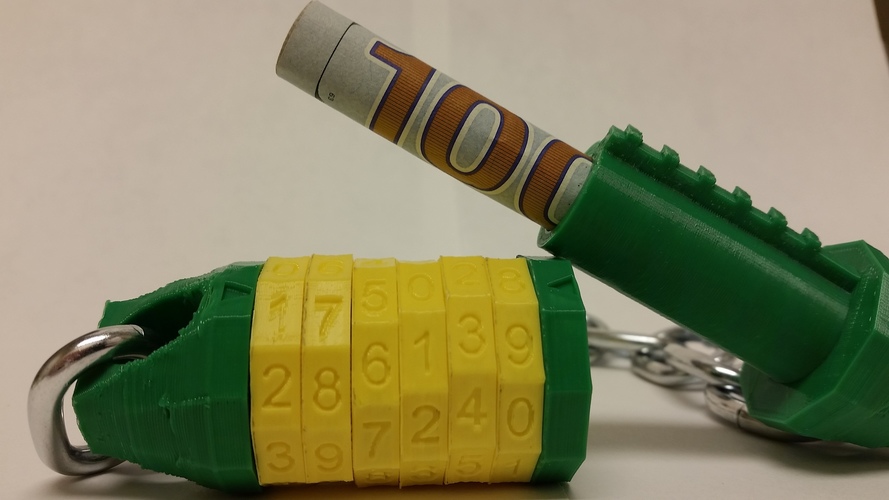
Linear Combination Locks
pinshape
Need a lock? Instead of buying one, why not print your own? DISCLAIMER: I am NOT responsible for stolen items or belongings that were locked with these locks. These locks are meant to test the limits of 3-D printers and pilot new frontiers for 3-D printing technology. There is a YouTube video that guides you through the process of making these locks. I worked really hard on it! Go check it out at: https://youtu.be/lNNb2r_JfSw If you wish to make these locks, there are a few things you will need: Plastic Cement Chain Links (Optional--Measurements shown in YouTube tutorial) Nylon Twine or Thin Steel Cable (For 2-digit lock ONLY) Heat source such as a lighter Exacto-Knife or flat-head screwdriver PRINTER SETTINGS: Printer: CoLiDo DIY -- PrintRite Slicer: Cura 2.3.1 Material: PLA Extruder Temperature: 190*C Bed Temperature: N/A Speed: 50-60mm/s EXCEPTION: When adding chains to the lock (See instructions). Infill: 30% or higher for a durable part. I used 10% for my demo locks. Brim: 8mm for ALL PARTS. Layer Height: 0.2mm Rafts: NO Support: NO INSTRUCTIONS: Step 1: First decide what type of lock you need and what its purpose will be. Once you decide what size of lock you need, print the Chamber and Cylinder files with the proper number of digits. Example: I need a 4-digit lock; I need to print: Chamber (4 Numbers) and Cylinder (4 Numbers). NOTE: Hollow Cylinders are hollow on the inside to allow storage of items inside the lock. Hollow Cylinders correspond with Hollow Chambers, and Solid Cylinders correspond with Solid Chambers. Step 2: Print the Digit Rings. These rings should spin freely around their axis. If they do not, you may need to use some heat treatment (see Step 4). Step 3: Print the End Ring. This is the most important ring in the whole lock. Step 4: There is a chance the Chamber half of the lock will need some heat treatment to clean up some of the overhangs. Near the top of the model (opposite end of the chain/mounting hole), there are a few slots that house the End Ring. Make sure to clean up these overhangs to ensure proper functionality of the lock. Step 5: Slide the digit rings onto the cylinder. Example: I want my combination to be 567314, so I need to print rings 5, 6, 7, 3, 1, and 4. I then slide the rings on the cylinder in the order 567314 from left to right. Step 6: Apply a thin band of plastic cement along the inner wall of the End Ring. Slot the End Ring into its housing at the end of the Chamber half. Slightly rotate the End Ring until it locks into place. NOTE: The notch in the End Ring MUST line up with the notch on the Cylinder! If this is done incorrectly, the lock will never lock/unlock! Step 7: Ensure all digits still spin properly, and clean up any excess plastic cement. Allow the cement to cure for 2-4 hours. Step 8 (2-Digit Locks ONLY): Thread some thin steel cable or nylon twine through the bottom loop of the Cylinder and Chamber halves to connect them together. That is the completed lock! When entering combinations into the lock, I recommend using your thumb to hold down digits that you have already entered into the lock. This prevents rings from binding with each other and ensures a successful unlocking/locking of the product. In order to lock and unlock this lock, the correct combination must line up with the arrows on the Cylinder and Chamber halves of the lock. For more information, check out the YouTube tutorial. Thanks for viewing my design! Have a nice day! -Frankie
With this file you will be able to print Linear Combination Locks with your 3D printer. Click on the button and save the file on your computer to work, edit or customize your design. You can also find more 3D designs for printers on Linear Combination Locks.
